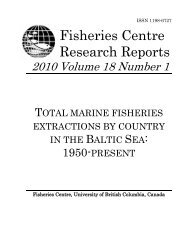Trends in GlobAl MArine Fisheries - Sea Around Us Project
Trends in GlobAl MArine Fisheries - Sea Around Us Project
Trends in GlobAl MArine Fisheries - Sea Around Us Project
You also want an ePaper? Increase the reach of your titles
YUMPU automatically turns print PDFs into web optimized ePapers that Google loves.
and their apparent irreversibility, it is ma<strong>in</strong>ly<br />
small, non-palatable, non-school<strong>in</strong>g fish species<br />
that will be able to survive the present onslaught.<br />
Conversely, he argued that the species that fisheries<br />
presently target (Table 2) will not survive<br />
what he called the “late Holocene”, and which<br />
many others refer to as the 6 th Ext<strong>in</strong>ction (see e.g.<br />
Eldredge 2001).<br />
Table 2. Mar<strong>in</strong>e fish that are unlikely to survive, given cont<strong>in</strong>uation<br />
of present fisheries trends (adapted from Parrish 1995, 1998,<br />
and Pauly 2000).<br />
Major features Representative groups<br />
Large- to moderate-sized,<br />
predaceous, territorial reef<br />
fishes and rockfishes with late<br />
age at maturity, very low<br />
natural mortality rates and<br />
low recruitment rates vs. adult<br />
stock size.<br />
Large- to moderate-sized shelf<br />
dwell<strong>in</strong>g, soft bottom predators<br />
susceptible to bottom trawl<strong>in</strong>g.<br />
Large- to moderate-sized<br />
school<strong>in</strong>g midwater fishes<br />
susceptible to midwater trawl<strong>in</strong>g.<br />
Large- to moderate-sized shelf<br />
dwell<strong>in</strong>g, school<strong>in</strong>g, pelagic<br />
fishes.<br />
Any species with exceptionally<br />
high monetary value.<br />
Whether or not Parrish’ scenarios will come<br />
to pass, there will be a need to monitor the impact<br />
of fisheries on their support<strong>in</strong>g ecosystems,<br />
a task for which appropriate <strong>in</strong>dicators are re-<br />
quired. Indicators, beyond the catches themselves,<br />
which can be used for this purpose <strong>in</strong>clude:<br />
<strong>Trends</strong> <strong>in</strong> global mar<strong>in</strong>e fisheries – a critical view<br />
Snappers, sea basses, emperors,<br />
rockfishes, sea breams.<br />
Cods, flounders, soles, rockfishes,<br />
croakers, skates.<br />
Hakes, rockfishes, armorheads,<br />
rougheyes.<br />
Bonitos, sierras, capel<strong>in</strong>, eulachon,<br />
salmon, sharks.<br />
Bluef<strong>in</strong> tuna, red snappers,<br />
halibuts, medic<strong>in</strong>al fishes,<br />
aquarium fishes, groupers,<br />
salmon, red mullets, billfishes.<br />
1. The taxonomic resolution of the reported catch<br />
over time (which however, has an <strong>in</strong>herent, if<br />
unknown bias, see Figure 2);<br />
2. The Mar<strong>in</strong>e Trophic Index (MTI), i.e. mean<br />
trophic level of the catch (see Table 1 and text<br />
below), and the related Fish<strong>in</strong>g-<strong>in</strong>-Balance<br />
(FiB) <strong>in</strong>dex (Pauly et al. 2000); and<br />
3. Stock-Catch Status Plots, based on catch time<br />
series (Pauly et al. 2008).<br />
These <strong>in</strong>dices are relatively easy to apply, as they<br />
require only catch time series (e.g., <strong>in</strong> the form<br />
of the global FAO catch dataset; see below) and<br />
estimates of trophic levels, available for essentially<br />
all fish species <strong>in</strong> the world (from FishBase;<br />
Froese and Pauly 2000) and for all commercially<br />
exploited groups (from the database of the <strong>Sea</strong><br />
<strong>Around</strong> <strong>Us</strong> <strong>Project</strong>; see www.seaaroundus.org).<br />
These <strong>in</strong>dices are here applied to Large Mar<strong>in</strong>e<br />
Ecosystems (LMEs), of which 64 are now de-<br />
f<strong>in</strong>ed (Sherman and Hempel <strong>in</strong> press) 2 , and which<br />
are gradually emerg<strong>in</strong>g as convenient entities to<br />
report fisheries trends (Pauly et al. <strong>in</strong> press).<br />
The ‘Biomass-Abundance-Difference<br />
<strong>in</strong> Area <strong>in</strong> Percent’ <strong>in</strong>dex (bA-dAP) –<br />
an <strong>in</strong>dicator based on the taxonomic<br />
resolution of the reported catch<br />
As mentioned above, fishers, like hunters, tend to<br />
concentrate preferably on large organisms. Thus,<br />
their catch <strong>in</strong>itially consists of few species, with<br />
even fewer <strong>in</strong>dividuals contribut<strong>in</strong>g the bulk of<br />
that catch. As the <strong>in</strong>itial target species become<br />
scarce, more species are targeted and contribute<br />
2. The currently def<strong>in</strong>ed 64 LMEs are likely to be re-def<strong>in</strong>ed <strong>in</strong>to 66 LMEs through splitt<strong>in</strong>g of the previously large and poorly def<strong>in</strong>ed Arctic LME,<br />
see www.seaaroundus.org.<br />
61





![Nacion.com, San José, Costa Rica [Nacionales] - Sea Around Us ...](https://img.yumpu.com/26166123/1/190x245/nacioncom-san-josac-costa-rica-nacionales-sea-around-us-.jpg?quality=85)










